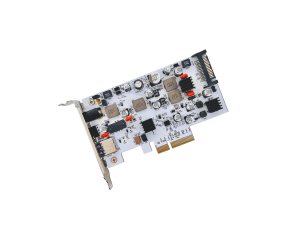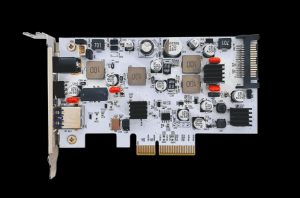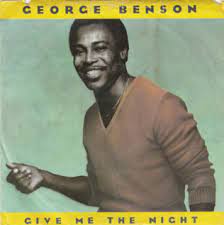SOTM TX-USBX10G review by Rob Dockery

 SOTM (Soul of the Music) is a South Korean audiophile brand focused on streamers, clocks, and power supplies and was the original company to produce an Audiophile USB card. My journey with SOTM began recently when I migrated my server from a full-featured and robust gaming motherboard to the SOTM SMB-Q370 motherboard. Shortly after installation, I was wowed by the new level of performance reached. But let’s focus on SOTM’s newly released USB card, the TX-USBX10G, which I am also excited to share with you.
SOTM (Soul of the Music) is a South Korean audiophile brand focused on streamers, clocks, and power supplies and was the original company to produce an Audiophile USB card. My journey with SOTM began recently when I migrated my server from a full-featured and robust gaming motherboard to the SOTM SMB-Q370 motherboard. Shortly after installation, I was wowed by the new level of performance reached. But let’s focus on SOTM’s newly released USB card, the TX-USBX10G, which I am also excited to share with you.
Standout features: The TX-USBX10G can be powered from its external facing DC barrel, the auxiliary power input on the PCB, OR a SATA input.
(special note: For those using the SCLK-EX within your server, like me, you can power this USB card with the SCLK-EX itself. There are two advantages to this: 1) You get to utilize the regulation of the SCLK-EX. 2) You do not have to give up another precious 12v LPS rail! And if you’re like me, those can get pretty expensive.)
The TX-USBX10G can be easily configured to use its internal or external clock. Later in this review, I will discuss how using the external clock changed this for the better—many configurable behavior traits regarding power via onboard jumpers.

Now that we’ve covered that let’s discuss the sound quality. There will be naysayers out there who suggest USB is a flawed audio protocol for sound quality or USB is digital. USB cards don’t affect sound quality because only 0s and 1s are being transported. Well, get any of those naysayers into a room with this card and a transparent system to have them compare a standard USB expansion card (or an ordinary motherboard USB port) to this card, and I have no doubt you will be able to sway their perception, with or without double-blind testing. The changes in sound quality are noticeable, tangible, and apparent in several categories.
Sense of space: The song We Will Become Silhouettes, by The Postal Service is a wonderful sounding track to showcase this strength of the TX-USBx10G. You’ll find yourself engulfed in the many subtle layers of sounds in unison, each playing into the other in a captivating way.
.jpg?KeepThis=true&TB_iframe=true&height=430&width=700) Clarity: Fire up Raul Midon’s Serendipity track, and the TX-USBx10G’s strength in clarity will teleport you into the mood this track intends to convey. With this card, you hear the reverberating texture of the guitar strings and the delightful decay.
Clarity: Fire up Raul Midon’s Serendipity track, and the TX-USBx10G’s strength in clarity will teleport you into the mood this track intends to convey. With this card, you hear the reverberating texture of the guitar strings and the delightful decay.
Separation: I could mention the Postal Service track again. That entire album wowed me with this card. It was like listening to newer versions of songs I had become very familiar with over the years, but I’ll give you a song you don’t think will ever be used for reviews such as these: All Alone on Christmas – Darlene Love. Being a huge Home Alone (1 and 2) fan, I found this song on my holiday listening list, and I had never heard the level of separation on the track before. So many instruments were there, playing harmoniously as Darlene belted it out. It is all presented in a day that does not make it “overly clean or filtered”. When you reach a certain point in this journey, you want less of that smoothing effect because it robs you of information you should enjoy.
 Texture/Openness: There is a lack of veil. There is no artificial “syrup” to the sound. If a vocal has a texture or grit, it will be presented to you in all its excellent glory. Several albums and songs come to mind. “Ginger Baker and The DJQ2O” (With special guest James Carter), George Benson (Give Me the Night, Off-Broadway), Janet Jackson’s “Velvet Rope,” “Fitzgerald & Pass…Again.” All of these albums feature very well-recorded tracks. A mature Fitzgerald presentation in the above-referenced album sounds incredibly emotional and captivating with the TX-Usbx10G. The immense and emotional saxophone throughout the Ginger Baker album is addicting. George Benson (Give Me the Night – Off-Broadway starts out calm, but halfway through, the band turns it up several notches as they hit their groove).
Texture/Openness: There is a lack of veil. There is no artificial “syrup” to the sound. If a vocal has a texture or grit, it will be presented to you in all its excellent glory. Several albums and songs come to mind. “Ginger Baker and The DJQ2O” (With special guest James Carter), George Benson (Give Me the Night, Off-Broadway), Janet Jackson’s “Velvet Rope,” “Fitzgerald & Pass…Again.” All of these albums feature very well-recorded tracks. A mature Fitzgerald presentation in the above-referenced album sounds incredibly emotional and captivating with the TX-Usbx10G. The immense and emotional saxophone throughout the Ginger Baker album is addicting. George Benson (Give Me the Night – Off-Broadway starts out calm, but halfway through, the band turns it up several notches as they hit their groove).
 The SOTM TX-USBX10G I tested was configured to receive power from the SCLK-EX board, which imparts its regulation technology and what you use to power the SCLK-EX. I prefer not to compare this card with the JCAT USB XE I reviewed (here). For those of you who have the SCLK-EX/SMB Q370 combo, the TX-USBX10G may be a better fit for you not only because of the synergy that exists between the two but also because you do not need to dedicate an additional (sometimes costly) LPS rail to this card.
The SOTM TX-USBX10G I tested was configured to receive power from the SCLK-EX board, which imparts its regulation technology and what you use to power the SCLK-EX. I prefer not to compare this card with the JCAT USB XE I reviewed (here). For those of you who have the SCLK-EX/SMB Q370 combo, the TX-USBX10G may be a better fit for you not only because of the synergy that exists between the two but also because you do not need to dedicate an additional (sometimes costly) LPS rail to this card.
The SOTM TX-USBX10G takes about seven days to break in. Yes, break-in is controversial, but the card stabilizes and reaches peak performance one week after you turn it on (if left on 24/7). It is not a problematic break-in; it sounds okay at any point throughout the process. You receive a card that sounds slightly subdued, eventually blossoming into greater clarity and texture. If you want to hear the plucks of a guitar or the breaths of a singer but don’t want those micro details to overpower the presentation, then this card may be a good fit for you.
 The value proposition is high with the TX-USBx10G. For $450.00, You can use this card as-is without external clocks. In my tests, the internal clock configuration still sounded wonderful. Compared to the SCLK-EX + Ref10 combination I use to enhance my server, the bass lost some control and detail, and the sound also did not present itself effortlessly, but this is in no way a negative sounding card in default form. As usual, this is a never-ending battle since even the power supply feeding the SCLK-EX affected the overall presentation. I don’t believe in “chasing perfection” but chasing what talks to your soul.
The value proposition is high with the TX-USBx10G. For $450.00, You can use this card as-is without external clocks. In my tests, the internal clock configuration still sounded wonderful. Compared to the SCLK-EX + Ref10 combination I use to enhance my server, the bass lost some control and detail, and the sound also did not present itself effortlessly, but this is in no way a negative sounding card in default form. As usual, this is a never-ending battle since even the power supply feeding the SCLK-EX affected the overall presentation. I don’t believe in “chasing perfection” but chasing what talks to your soul.
Ease of operation: The card is plug-and-play. It arrives configured for internal clock operation. When/if you decide to use an external clock option, all you do is remove a jumper and relocate another, and the card will be ready for external clock sources. As for power – please ensure you power on the card prior to the rest of your server.
So, if you are like me and take your computer server source to EXTREME lengths to extract as much performance from your system as possible, the TX-USBx10G might be what you need. The clock input frequency of 20mHz is not standard, so you will need help finding suitable aftermarket options outside of the SCLK-EX, which adds significant cost to your system but is worthwhile. Still, if you already have an external reference clock, the SCLK-EX/TX-USBx10G combination with clock input could be tough to beat.
![]()
![]()
Specifications:
Price: $450
Website: https://www.sotm-audio.com/sotmwp/english/portfolio-item/tx-usbx10g/
Rob’s Associated equipment list
Source: DIY Music Server (I do not upsample)
DAC: Yggdrasil More is Better (I interchange with A2/OG / LIM analog boards/firmware) W/ Unison USB
Preamp: Wyred4Sound STP SE-Stage 2 Preamp
AMP: Rogue Audio ST-100
Speakers: Natalie P – Jon Marsh Design (DIY) – (Crossover consists of Duelund, Jantzen Z-Superior/Silver, Auricap XO capacitors, Mills Resistors, Aircore inductors, Jupiter 18awg solid core wire for tweeters, Jupiter 14awg solid core wire for Mids/Bass).
Subwoofer: Rythmik Audio F12 sealed 2^ft3 enclosure
DIY Music Server Details
Case: HDPlex H5 Gen2 Case
Motherboard: Dual Xeon / Asus Sage C621 or
SOTM SMB-Q370 w/ sclk-ex (Previously Gigabyte Designare Z390 and Previously Asus Strix Z390-I)
CPU: Xeon Silver 4210 and/or i9 9900K @ 5ghz
Storage: Revelation Audio SSD NVMe via PCI-E adapter for OS (CPU Direct and LPs powered) and 1TB 670P SSD for Music Storage
RAM: Apacer DDR4 2666 32GB ECC
USB Controller: JCAT USB XE with JCAT clock (or Sclk-EX) followed by TX-USBhubin with sclk-ex clocking.
USB Cables: Tubulus Concentus USB ( previously Sablon 2022 Evo USB Cable (Previously Sablon 2020 USB)
Network card: Startech PEX1000SFP2 – Modded clock input – DC4 powered
SFP Module: Finisar 1318 SFP
DC Cables: DIY Mundorf Silver/Gold 24-Pin ATX / DIY Mundorf Angelique
DC-ATX: Taiko Audio DC-ATX
EPS Cable : 8pin – 15.5awg Mundorf Angelique
DIY Taiko/Nenon Unregulated LPS v3(Previously Paul Hynes SR7T Dual rail 19v(Mundorf Silver/Gold 15.5awg on 19V output))
Software
Euphony V4 OS | 5.18.0-rt11-17-rt-bfq-dev kernel
HQ Player 4.30
Network
Spectrum > Arris SB8200 > Silver RJ45 with Telegartners > Ubiquiti EdgeRouter ER-4 modded with clock input (AfterDark) SFP > DIY Ethernet cable> B-Side Uptone Etherregen > FS.com 23awg passive silver-plated copper DAC cable > Music server A-side
Linksys EA7500 for wireless control – bridged mode > Fiber Cable > Startech FMC > Ubiquiti EdgeRouter ER-4 SFP Fiber input
Server and associated equipment on separate dedicated vlan.
Linear Power
Sean Jacobs DC3 – Resting for now
Paul Hynes SR7T 12V and 19v modded rectification and output mosfet : 12V on the Arris SB8200
Sean Jacobs DC4- Revelation Femto NVME
Sean Jacobs DC4 – JCAT USB XE
Sean Jacobs DC4 – SCLK-EX
Sean Jacobs DC4 – Etherregen
Sean Jacobs DC4 – Edgerouter ER-4 Afterdark version with 10mhz clock input.
Network Switch Mods
1. Buffalo BS-GS2016P: a. SMPS removed 2. Mundorf Silver/Gold 15.5awg to DC input. (No longer in use)
2. Buffalo BS-GS2016P: a. SMPS removed 2. Mundorf Angelique 15.5awg wire to DC input. (No longer in use)
From the wall
DIY Mundorf CAW 5awg cable to Uberbuss using Bocchino Palladium plated plugs
Sablon Prince on the amp
QSA Red Receptacle
Pi Audio Uberbuss with Uberpuertos
Reference Clocks
Mutec Ref10 – 1. Sclk-Ex | 2. AD Nic | 3. Etherregen | 4. Edgerouter ER-4
LHY Ock-1 – Secondary (Offline)
Stereo Times Masthead
Publisher/Founder
Clement Perry
Editor
Dave Thomas
Senior Editors
Frank Alles, Mike Girardi, Russell Lichter, Terry London, Moreno Mitchell, Paul Szabady, Bill Wells, Mike Wright, and Stephen Yan,
Current Contributors
David Abramson, Tim Barrall, Dave Allison, Ron Cook, Lewis Dardick, John Hoffman, Dan Secula, Don Shaulis, Greg Simmons, Eric Teh, Greg Voth, Richard Willie, Ed Van Winkle, Rob Dockery, Richard Doron, and Daveed Turek
Site Management Clement Perry
Ad Designer: Martin Perry







Be the first to comment on: SOTM TX-USBX10G review by Rob Dockery